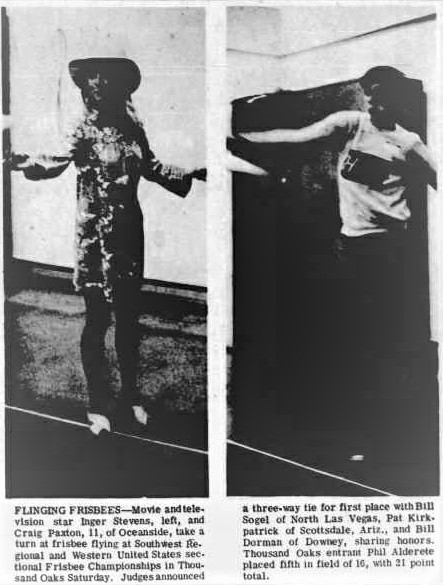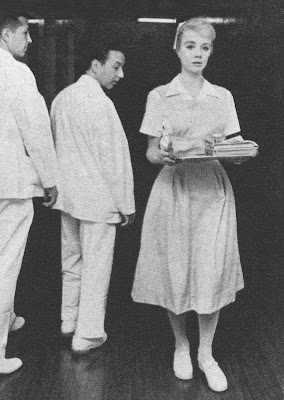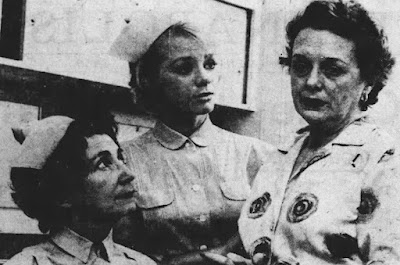Empire was a western series that aired on NBC from 1962 to 1963 then was retailored as Redigo for the 1963 to 1964 season. The show revolved around ranchmen in New Mexico and starred Richard Egan, Charles Bronson, Ryan O'Neal, and Warren Vanders.
Inger Stevens made a guest appearance on the Duet for Eight Wheels episode that aired on April 30, 1963. (Full episode is available on Youtube. This post contains spoilers.) In the episode, Redigo (Egan), Garret (O'Neal), Moreno (Bronson), and Chuck (Vanders) are capturing wild mustangs. Jim Redigo becomes paralyzed after being trampled by one of the horses.
Redigo's pride makes him struggle to accept his new condition. While Garret is with Redigo in the hospital, Moreno and Chuck are watching the elusive stallion. Moreno says, "Well, there's one sure thing about kings. Titled or untitled, they've got a lot of pride. And, man, that pride...it can be a throne or a trap depending how you use it."
The doctor recommends that Redigo have another wheelchair user with the same condition to advise him on daily functions.Redigo rejects help and is angry when the fellows try to help make his home more accessible. He's even angrier when he realizes his therapy coach is a paraplegic woman named Ellen Thompson (Inger Stevens).
Redigo: This is a ranch. It takes men to run it and it takes men to run the men who run it. A ranch is a contest with nature and nature is built on strength. Your Dr. Karr can't expect men to listen to a man who has to listen to a woman.
After Ellen explains that he's more likely to listen to a woman than a man in his situation, Redigo questions her.
Redigo: Is it always this sort of a contest?
Ellen: Contest? Contest with this. It's always a contest with this [wheelchair]. At first, it's like being born with a number of left hands. Everything seems numb and pointless. And then you adapt. That's the great part of being human. When you run up against something, you find a way around it and this is ours.
Redigo: Yours.
Ellen: Ours.
Redigo submits to the therapy. Ellen shows him how to do indoor tasks, drive, and swim. Redigo learns how much strength it takes to do the smallest of tasks on his own. He's frustrated, but determined.
Redigo insists that the stallion be shot, but his men refuse.
[The following exchange can also be viewed in a clip on the Inger Blog Youtube channel.]
Ellen: Please don't do it.
Redigo: Has Moreno been talking to you about this?
Ellen: Yes, but only because he...
Redigo: Helping to run the ranch is one thing you don't have to worry about.
Ellen: Only because he was concerned about you.
Redigo: And he's confused about his duties, too. I already have a nurse maid.
Ellen: Why do you want to shoot the stallion? For revenge?
Redigo: No! For something like that...wild and free...in a trap?
Ellen: Oh, you didn't think that way about the trap...
Redigo: But nobody's gonna keep me in this for the rest of my life.
Ellen: Do you think his life will be worthless that way?
Redigo: Worse! When an animal is suffering or injured, then we do away with it out of kindness. For that horse captivity would be torture.
Ellen: That's rather God-like, isn't it? To make the decision about the worth of a life other than your own? You think it would be true for that wild, free thing. You think it would be true for yourself, but you believe you will escape. Well, I've been in this thing six years, Mr. Redigo. Is that what you think of my life? Worse than worthless?
She attempts to throw herself from the wheelchair but he catches her, pulls her close, and they kiss.
The pair falls in love. After seven weeks, Redigo is approved for an experimental surgery but will not undergo the operation unless Ellen does, too. He doesn't realize that Ellen's chances of surviving the operation are slim.

Knowing he must undergo the surgery and hoping that taking the risk will be a success for her as well, Ellen agrees to the procedure without revealing the danger. As is frequently the case for Inger's television characters, Ellen suffers a tragic fate.
 |
| Press photo for the show |




































